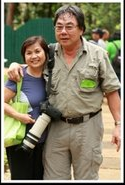At the beginning of each term, as I face a new class, I
always ask my students what specialization they wish to get into. Nowadays,
it’s mostly fashion or travel, but I came upon a demure, slim, very feminine
looking girl – probably 18 0r 19 years old – who very shyly said “war
photography.” I wasn’t sure that I heard her right, so I asked again, and in
almost a whisper, she repeated, “War photography. I would like to be a war
correspondent.”
I was intrigued. I asked her why she had thought of becoming
a war photographer. She said that as a child, she came upon some
black-and-white war pictures and saw the strong emotions portrayed in them, and
since then, she has been wanting to do the same kind of powerful imagery. She
wanted her photographs to be memorable.
Since I did not want to pay singular attention to her, I
moved on to ask the others, but I continued to be intrigued by her ambition,
since it seemed inconsistent with her appearance and demeanor.
On our third session, we delved deeper into the different
genres and the personal characteristics of the photographers pursuing each
specialization – that someone who would like to do fashion photography would do
well being fashionable herself, that a landscape photographer should be an early
riser to catch the fleeting sunrise of a beautiful morning. That someone who
wanted fixed hours should not do advertising photography, which we know demands
work beyond normal hours, but probably should work in a portrait studio in a
mall. As I went through each of my students’ choices, I named a few very well
known photographers who represented each genre.
When we touched on war photography, I named a famous
Filipino photographer who had covered the war in Iraq and Afghanistan but
somehow, in an effort to put across the message that war photography has its
own intrinsic risks and extraordinary demands, I got drawn to cite John’s own
experiences while covering coup détats. I related that I would be nervously
praying for his safety every time he left the house for such assignments. At
that time, the military was restive and John was doing photography for
Asiaweek.
I asked her if her family would be able to accept the risks
that she would face as a war photographer. She did not answer. Is she physically
fit and mentally agile? Would she be
able to think on her feet to make split-second decisions that may be necessary
to save her own life?
A scene flashed in my head – of a story that I heard from
John, and for which I am eternally grateful that he survived and I did not have
to witness. He was covering one of a few attempts to overthrow the Corazon
Aquino administration. John said that he had aimed his camera at a soldier, a
bit far from him but within the range of his telephoto lens, who was aiming his
rifle at a civilian, when suddenly, he found the end of the soldier’s gun aimed
at him. For a nanosecond, he froze, then realized that he had to disengage from
this encounter. Understanding that the soldier must have been also tense at the
moment, he did not want the soldier to further feel challenged, so without
looking at him, and in the slowest manner, he turned his telephoto away from
the soldier and downward to the ground. He pivoted his body to also turn away
from him, took a well-planned step, again in the same slow-motion fashion that
made a few seconds seem like eternity. Still curious as to how the soldier was
reacting to him, he caught from the corner of his eye that the soldier also
turned and walked away from where he stood. John withheld even a sigh of relief
so as not to call further attention to his presence. During that tense moment, the
last thing he wanted to hear was the sound of a gunshot, since silence meant
that he was still alive.
After covering a few coup d états, John was starting to
believe that he would make a good war correspondent. He probably would have, but it would have come
at the expense of my sanity. He told me that if he didn’t have a family, he
would have gone. I am glad and grateful that he went back to being an advertising
photographer. It’s not exactly an uneventful life – something that is hard to
do with John - but at least we were far from a war photographer’s daily dose of
life-or-death situations.
I hope my student listened to my narrative about John. It was
not just a story - it was my personal
plea for her to reconsider her choice of a career in photography. But then, I know of course, that it is her decision and not mine.
